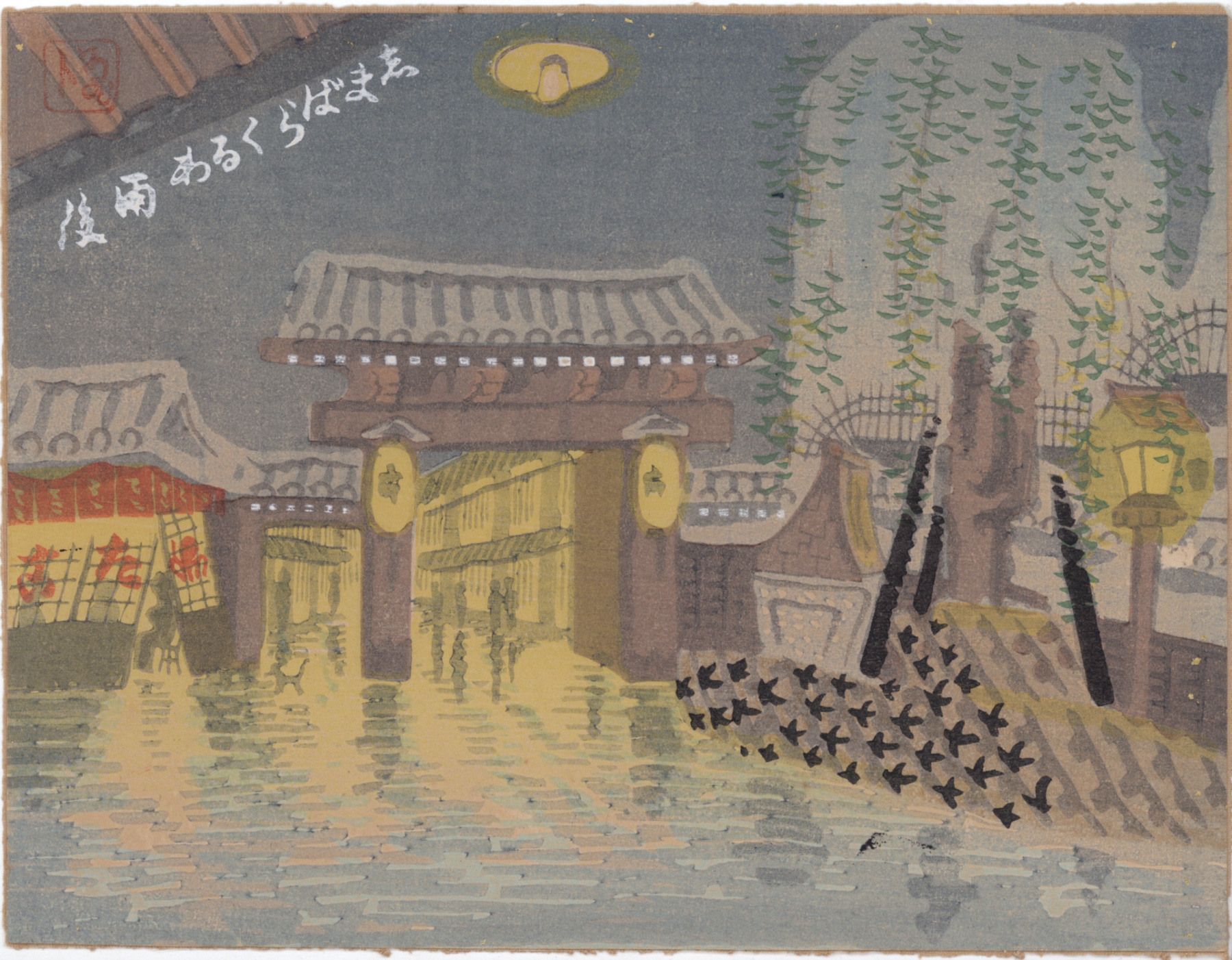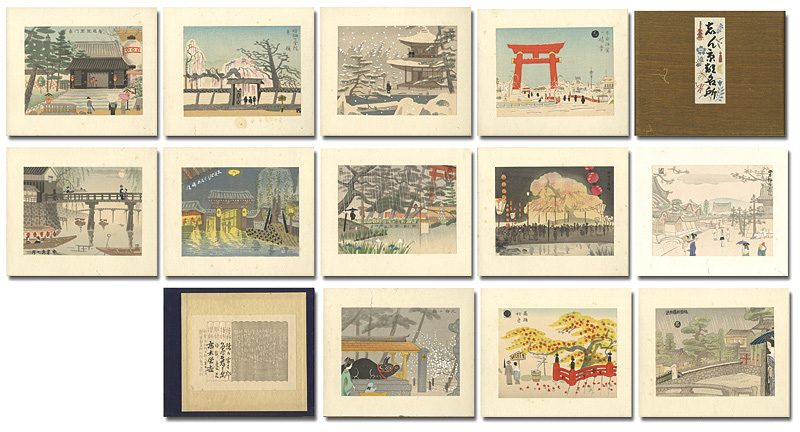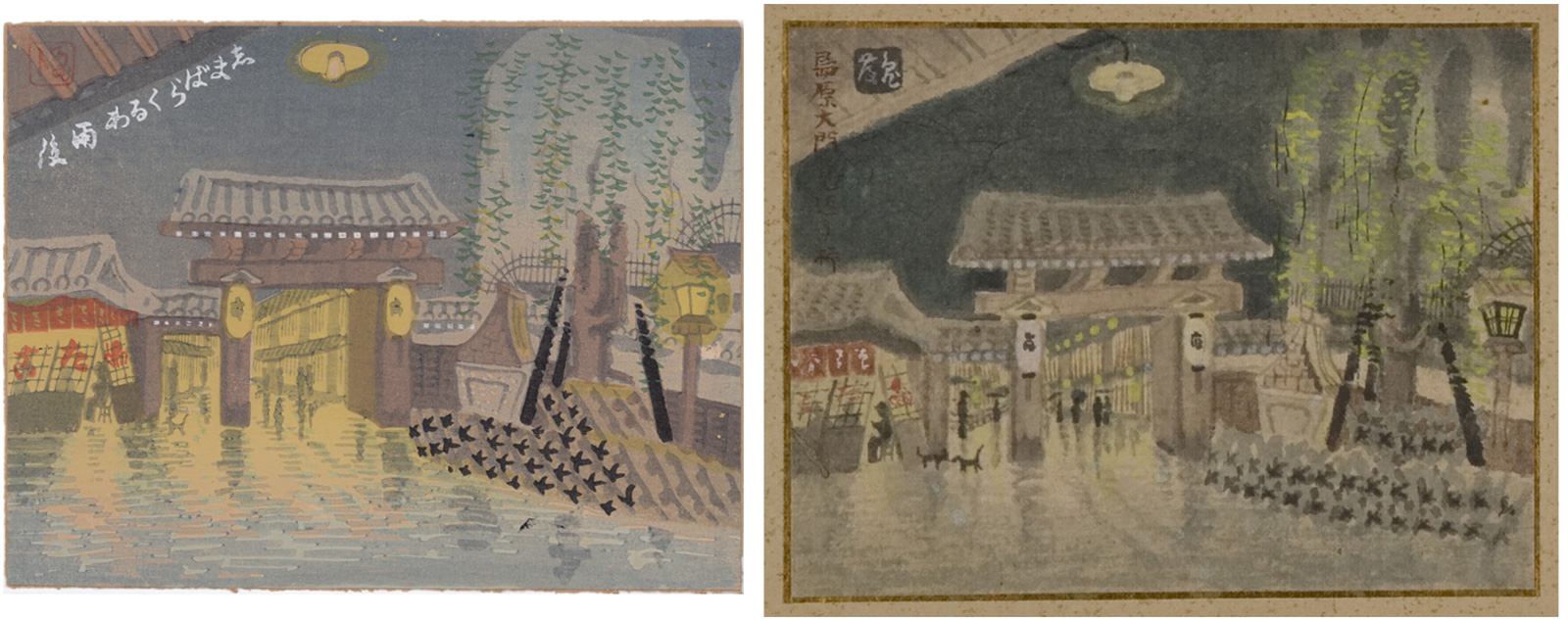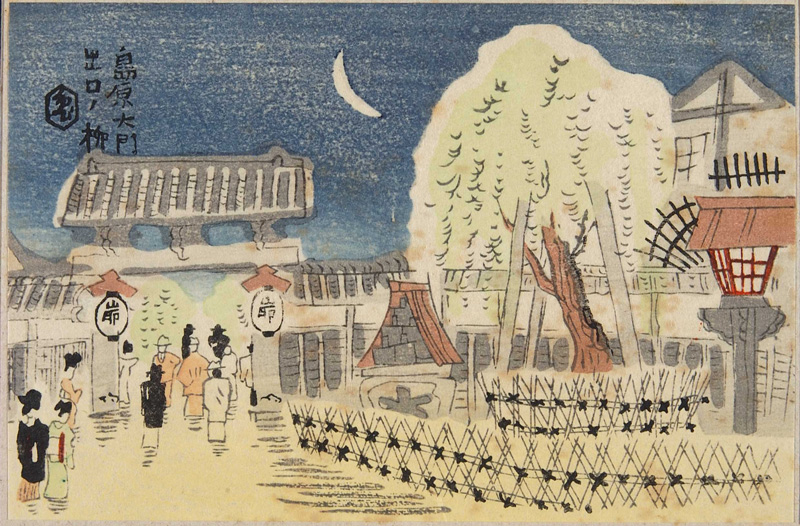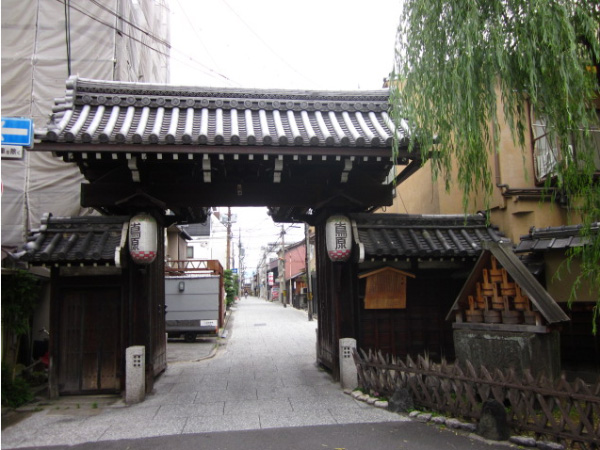 | Japanese Color Woodblock PrintShimabara District After the Rainfrom the series New Famous Views of Kyotoby Kamei Tōbei, after 1953 |
IHL Cat. #1126
(print is mounted on portfolio heavy backing paper which is trimmed almost to the image)
IHL Cat. #2190
(print is trimmed to image and mounted on portfolio heavy backing paper)
About This Print
One of twelve small-size prints (approx. 5 x 6.5 in.) from the portfolio titled New Famous Places of Kyoto (志ん京都名所 Shin Kyōto meisho), designed by the artists Kamei Tōbei (1901-1977) and Tokuriki Tomikichirō (1902-2000)1, and published by the New Famous Places of Kyoto Publication Society (新京都名所刊行会).
The two artists often collaborated and the publishing entity New Famous Places of Kyoto Publication Society, is likely a construct of the two artists.
This print depicts the main gate entrance to Shimabara, Kyoto's former red-light district, after a night rain. When this print was made Shimabara was still a licensed entertainment area. Lynn Katsumoto notes: "The sign on the stand to left says 'tako' - the 'yaki' is left off, but I think that's what most people assume. Tako yaki are little bready balls with bits of octopus inside, popular street fare."2 A crude drawing of an octopus appears to the right on the stands curtain. (See detail below.)

1 It is unclear if Tokuriki actually designed any of the prints themselves as all the prints carry some version of Kamei's artist seal.
2 With thanks to Japanese art historian extraordinaire, Lynn Katsumoto.
The Complete Portfolio
Six or more of the print designs in this portfolio seem to have also been issued at another time, possibly printed using different blocks. The website of The Agency of Cultural Affairs - Cultural Heritage Online contains six of these prints, with each print visibly different from the prints in this collection. As with this collection's prints, their prints are not dated, but they attribute the prints to Kamei Genbei, a name used by Kamei after 1953, which helps narrow the publication dates to post-1953.
Comparison of the Two Editions
This Collection's Print IHL Cat. #1126 版画集 『新京都名所 [New Views of Kyoto]』 原画 3 島原廓雨後 [Shimabara District After the Rain]はんがしゅう しんきょうとめいしょ げんが 3 しまばらくるわうご亀井 玄兵衞 (かめい げんべい) [Kamei Genbei (1901-1977)]
制作年不詳 [production year unknown]
本紙12.1×15.8cm [4.76 x 6.22 in.] /ページ寸22.8×27.8 cm [size of page print is mounted on.]
The Agency of Cultural Affairs - Cultural Heritage Online[from the collection of The Museum of Modern Art, Wakayama]
http://bunka.nii.ac.jp/SearchDetail.do?heritageId=221433
Kamei also created a much earlier 1926 version of the same locale, as can be seen from the below print from Ritsumeikan University's Art Research Center.
Shimabara District
Source: japanvisitor.com http://www.japanvisitor.com/kyoto/kyoto-districts/shimabara-kyoto
Shimabara, located to the west of Nishi-Honganji Temple along Hanayacho Street in Kyoto, is a former licensed courtesan and later geisha area of the city.
The first licensed "entertainment area" in Kyoto was established by Toyotomi Hideyoshi at the junction of present-day Nijo and Yanaginobanba. This later moved to an area just to the north of Nishi-Honganji and then again in 1640 to where it stands today, in an area known at the time as Nishishinyashiki, but popularly referred to as "Shimabara," perhaps after the uprising by peasants in Shimabara in Kyushu from 1637-1638 or the resemblance of the main gate to that at Shimabara Castle. No-one really knows for sure!
Shimabara prospered as red-light district until 1958 when prostitution was made illegal in Japan and the geisha quarter survived until the 1970s. Shimabara was one of the three main licensed prostitution quarters established by the Tokugawa regime to control the practice. The other two were Yoshiwara in Edo (Tokyo) and Shinmachi in Osaka. Originally the Shimabara Pleasure Quarters would have been enclosed by a wall and surrounded by a moat.
The entrance gate to Shimabara still stands and is a fine narrow, wooden gate with a tiled roof. A stack of wooden buckets stands by the gate as a reminder of the threat of fire to the wooden buildings that once stood within. Two former teahouses/restaurants/bordellos remain from the Edo Period.
Print Details
| IHL Catalog | #1126 and #2190 |
| Title | Shimabara District After the Rain Shimabara kuruwa ugo しまばらくるわ雨後 |
| Series | New Famous Places of Kyoto 志ん京都名所 |
| Artist | Kamei Tōbei (1901-1977) |
| Signature | not signed |
| Seal |  |
| Date | after 1953 |
| Edition | unknown |
| Publisher | 新京都名所刊行会 New Famous Places of Kyoto Publication Society |
| Impression | IHL Cat. #1126 and #2190: excellent |
| Colors | IHL Cat. #1126: good; IHL Cat. #2190: excellent |
| Condition | IHL Cat. #1126: good - backed with stiff paper trimmed to the image (the original mounting trimmed) IHL Cat. #2190: excellent |
| Genre | sosaku hanga (creative print) |
| Miscellaneous | |
| Format | yotsugiri |
| H x W Paper and Image | IHL Cat. #1126: 4 13/16 x 6 3/8 in. (12.22 x 16.19 cm) IHL #2190: 4 3/4 x 6 5/16 in. ( 12.1 x 16 cm) IHL #2190 backing paper: 7 1/16 x 8 1/4 in. (17.9 x 21 cm) |
| Collections This Print | The Museum of Modern Art, Wakayama http://www.momaw.jp/search-db/heritage-list.php?&creatorName=%E4%BA%80%E4%BA%95&pageSize=20 |
| Reference Literature |
10/13/2019

